
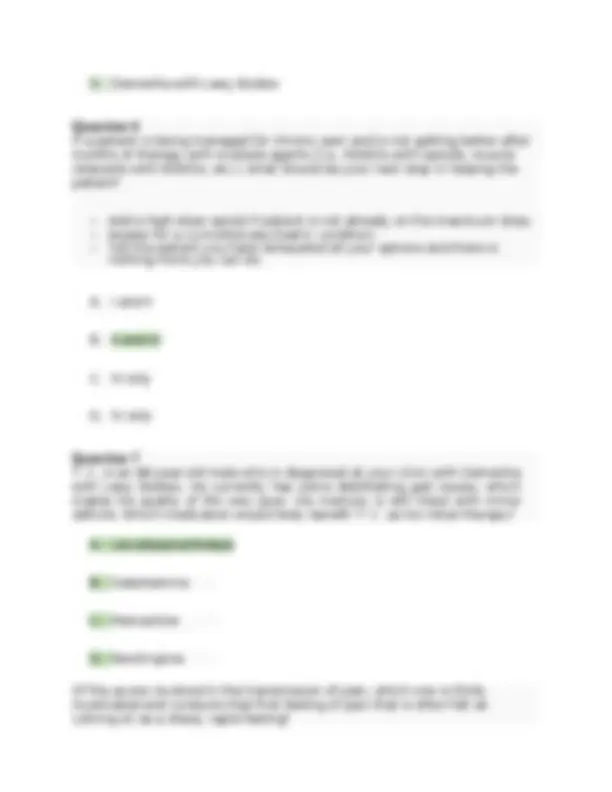
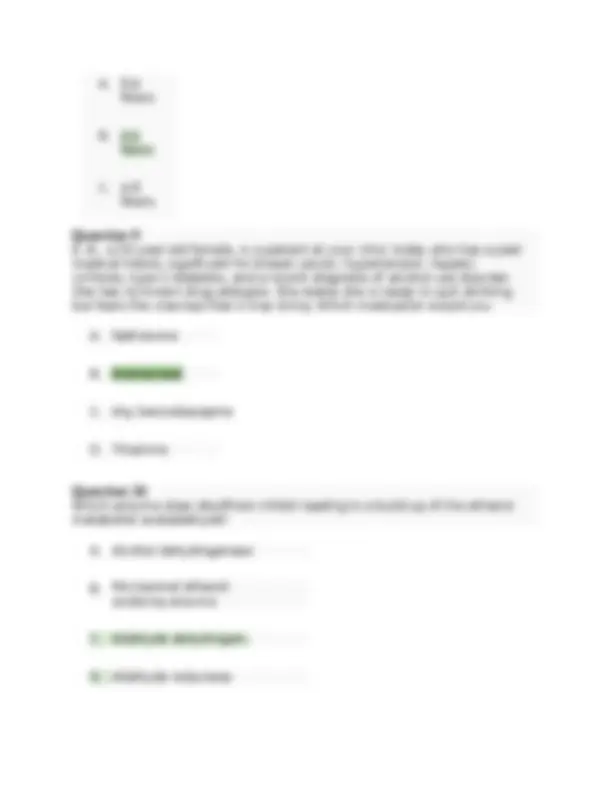
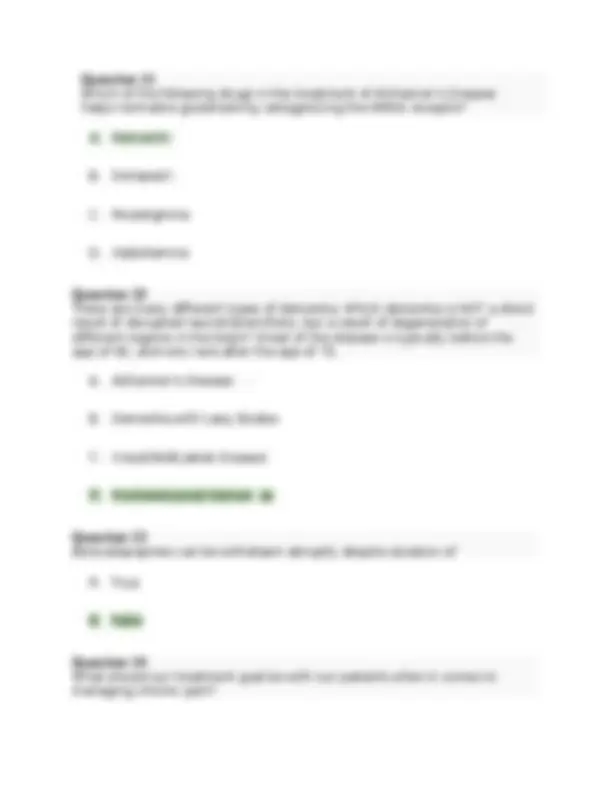
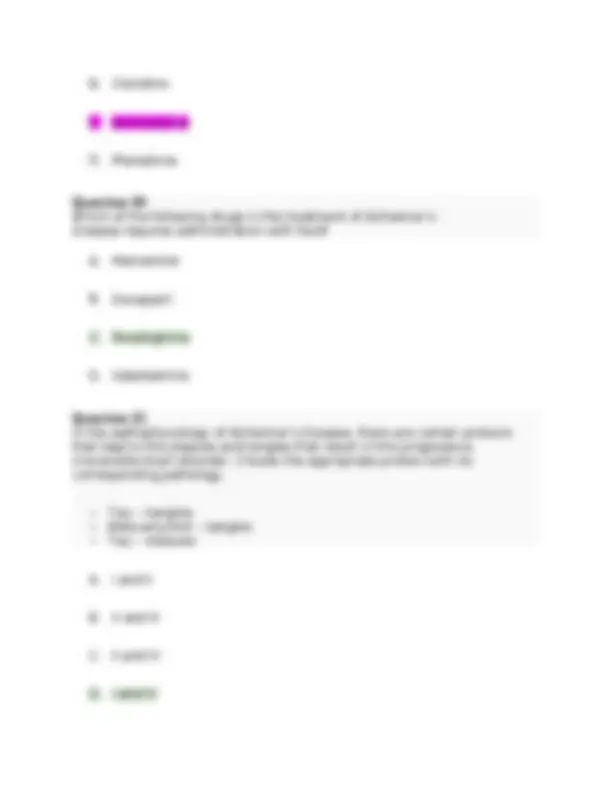
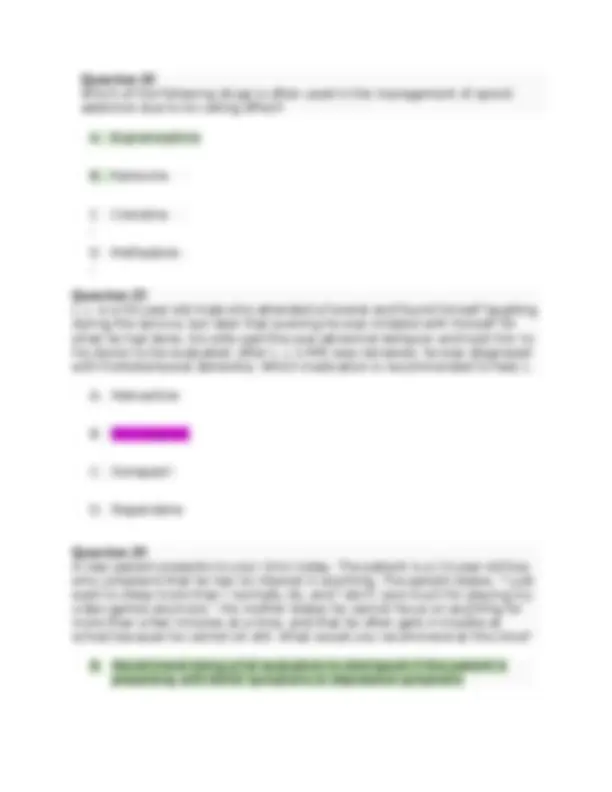
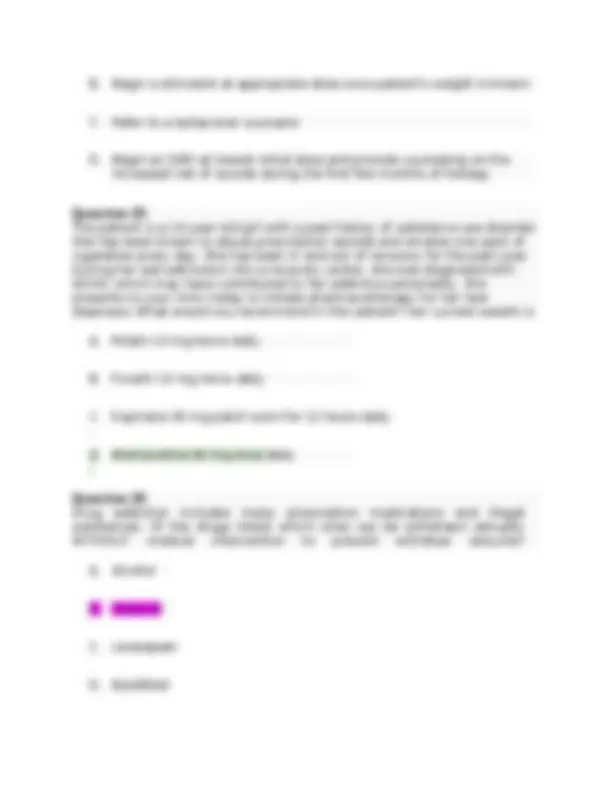
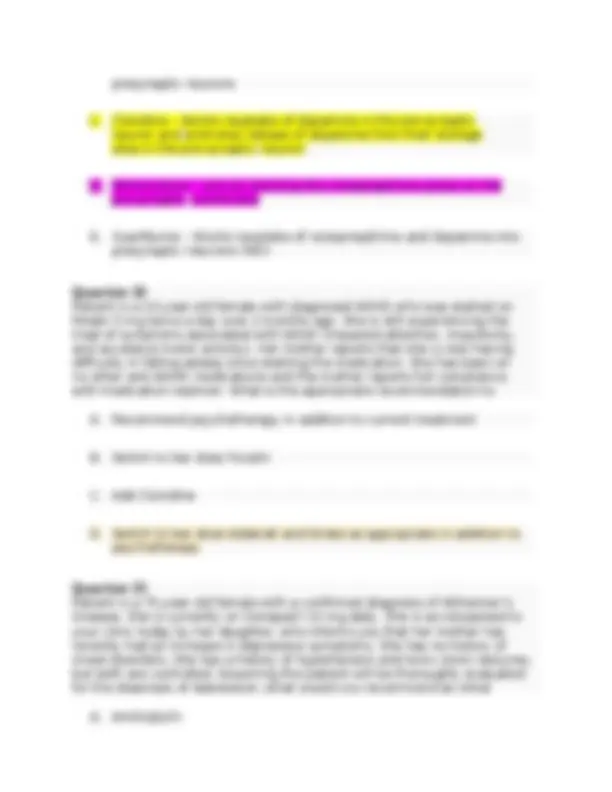
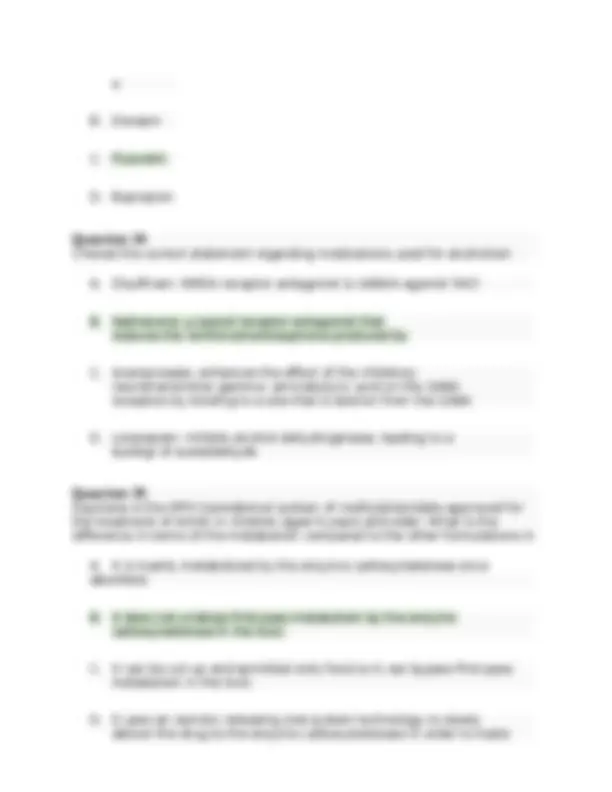
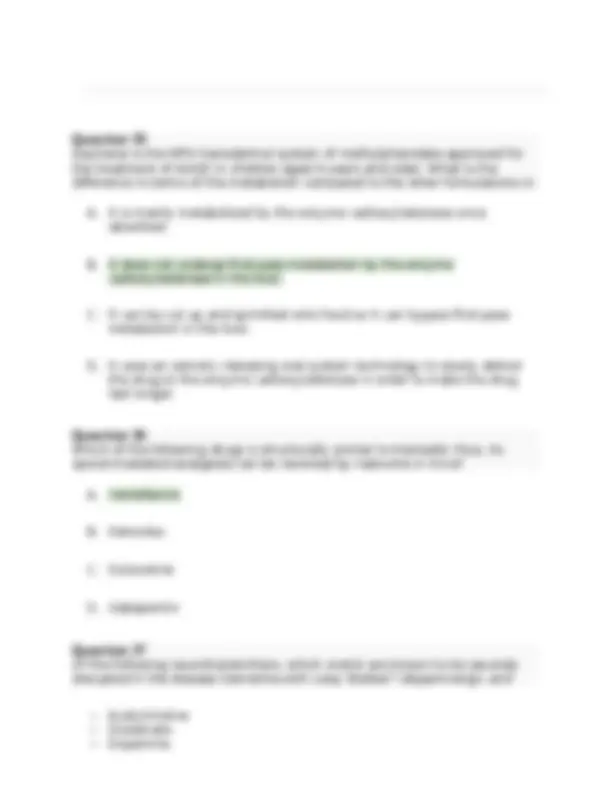
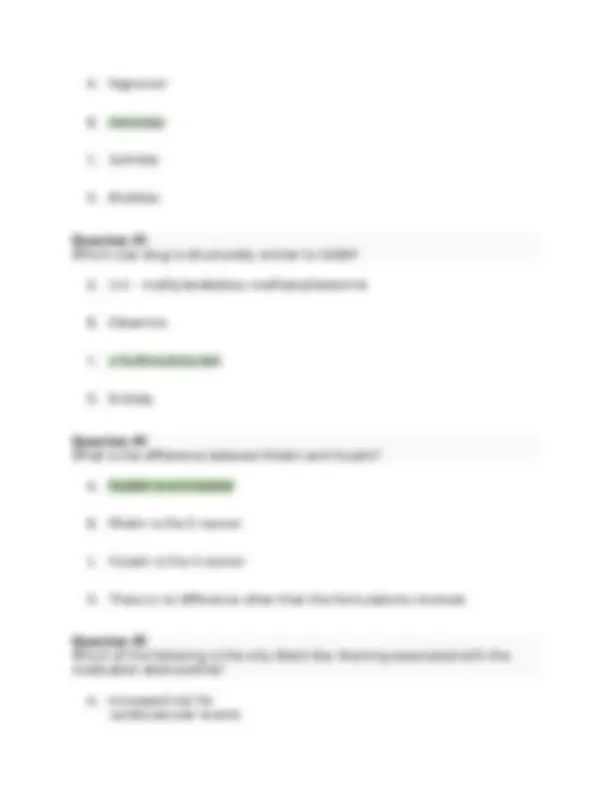
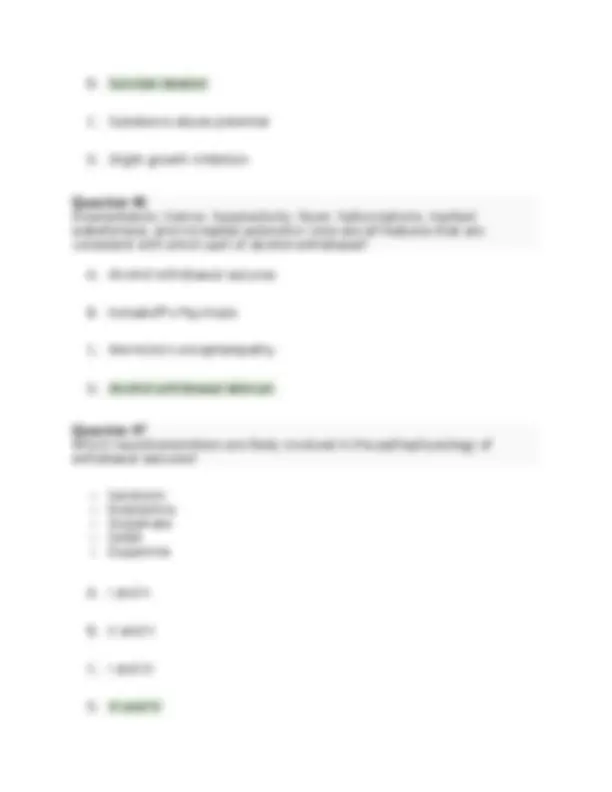
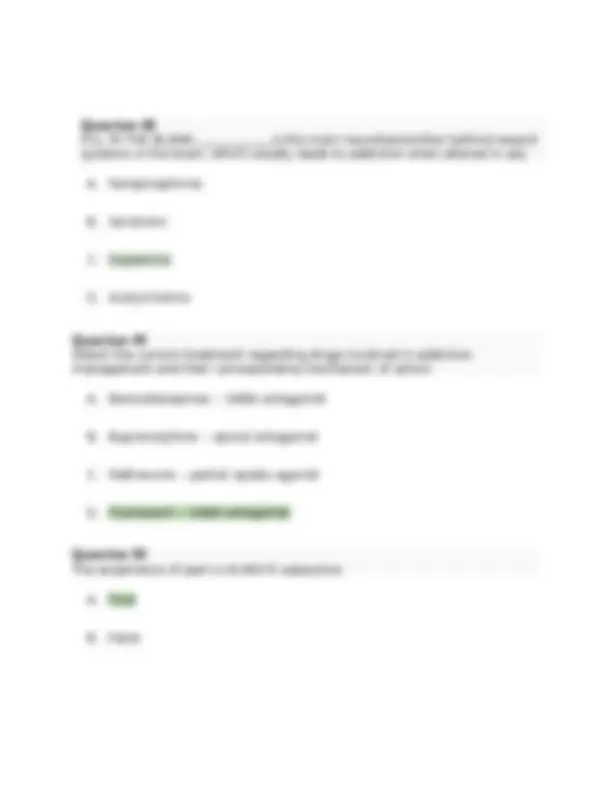


Study with the several resources on Docsity

Earn points by helping other students or get them with a premium plan


Prepare for your exams
Study with the several resources on Docsity

Earn points to download
Earn points by helping other students or get them with a premium plan
Community
Ask the community for help and clear up your study doubts
Discover the best universities in your country according to Docsity users
Free resources
Download our free guides on studying techniques, anxiety management strategies, and thesis advice from Docsity tutors
NURS 6630 Week 11 Final Exam Fall 2021-2023 graded A+NURS 6630 Week 11 Final Exam Fall 2021-2023 graded A+NURS 6630 Week 11 Final Exam Fall 2021-2023 graded A+NURS 6630 Week 11 Final Exam Fall 2021-2023 graded A+NURS 6630 Week 11 Final Exam Fall 2021-2023 graded A+
Typology: Exams
1 / 20

This page cannot be seen from the preview
Don't miss anything!













Which medication(s) requires a test dose to determine accurate use of the drug (i.e., how addicted the patient truly is on a certain drug) before beginning a titration schedule to withdrawal the patient?
What baseline levels should you perform before initiating an anti-ADHD Electrolytes, height, weight, white- blood cells ECHO, heart rate, pulse Height, weight, blood pressure, pulse Blood pressure and pulse
Which medication below would you use in addition to benzodiazepine treatment if the patient is experiencing psychosis during alcohol withdrawal delirium? Which medication below would you use in addition to benzodiazepine
If a patient suffers from a multitude of small strokes and later begins experiencing mood d D. Chlordiazepoxide C. Propofol B.Haloperidol A.Naltrexone Which of the following psychiatric conditions is present in both domains (i.e., core psychopathology & pain-related psychological symptoms) of chronic pain that will likely lead to an outcome of disability, pain, and poor quality of A. Major depression B. Personality disorder C. Anger D. Anxiety A. Vascular Dementia B. Frontotemporal Dementias C. Alzheimer’s Disease
Microsomal ethanol oxidizing enzyme
E. B., a 55-year-old female, is a patient at your clinic today who has a past medical history significant for breast cancer, hypertension, hepatic cirrhosis, type 2 diabetes, and a recent diagnosis of alcohol use disorder. She has no known drug allergies. She states she is ready to quit drinking but fears the cravings that it may bring. Which medication would you
Which enzyme does disulfiram inhibit leading to a build-up of the ethanol metabolite acetaldehyde? A. ß-∆ fibers B. A-∆ fibers C. A-ß fibers A. Naltrexone B. Acamprosate C. Any benzodiazepine D. Thiamine A. Alcohol dehydrogenase B. C. Aldehyde dehydrogenase D. Aldehyde reductase
There are many different types of dementia. Which dementia is NOT a direct result of disrupted neurotransmitters, but a result of degeneration of different regions in the brain? Onset of the disease is typically before the age of 60, and very rare after the age of 75.
Benzodiazepines can be withdrawn abruptly despite duration of
What should our treatment goal be with our patients when it comes to managing chronic pain?
Which of the following drugs in the treatment of Alzheimer’s Disease helps normalize glutamate by antagonizing the NMDA receptor? A. Memantine Donepezil Rivastigmine Galantamine Alzheimer’s Disease Dementia with Lewy Bodies Creutzfeldt-Jakob Disease Frontotemporal Dementias True False
SSRIs can be used in alcohol use disorder and offer modest drinking reduction through an anti-craving effect.
Y. R. is a 35-year-old woman who presents to your clinic today complaining of ankle pain. She said she was running the trail when she saw a snake. During a quick turn to run away from the snake, she twisted her ankle. Which of the following medications may be a good choice in helping Y. R. with her Amitriptyl in e
Of the following medications, which one is contraindicated with stimulants such as Ritalin or Adderall? (an MOA)
C. I and IV D. A. B. A. B. C. D. A. II and IV III only True False Oxycodone Ibuprofen Duloxetine Atomoxetine
Which of the following drugs in the treatment of Alzheimer’s Disease requires administration with food?
In the pathophysiology of Alzheimer’s Disease, there are certain proteins that lead to the plaques and tangles that result in this progressive, irreversible brain disorder. Choose the appropriate protein with its corresponding pathology.
Clonidine Amitriptyline Phenelzine Memantine Donepezil Rivastigmine Galantamine I and II II and III II and IV I and IV
Begin an SSRI at lowest initial dose and provide counseling on the increased risk of suicide during the first few months of therapy
The patient is a 16-year-old girl with a past history of substance use disorder. She has been known to abuse prescription opioids and smokes one pack of cigarettes every day. She has been in and out of recovery for the past year. During her last admission into a recovery center, she was diagnosed with ADHD, which may have contributed to her addictive personality. She presents to your clinic today to initiate pharmacotherapy for her new diagnosis. What would you recommend in this patient? Her current weight is
Drug addiction includes many prescription medications and illegal substances. Of the drugs listed, which ones can be withdrawn abruptly WITHOUT medical intervention to prevent withdraw seizures?
Atomoxetine 60 mg once daily A. C. D. Begin a stimulant at appropriate dose once patient’s weight is known Refer to a behavioral counselor Ritalin 10 mg twice daily Focalin 10 mg twice daily C Daytrana 30 mg patch worn for 12 hours daily . D . Alcohol B. Adderall Lorazepam Butalbital
T. B. is a 55-year-old male who has diagnosed with type 2 diabetes 10+ years ago. He has since had complications from the disease and is suffering from severe neuropathy. On top of that, T. B. is struggling with his mental health and was recently told he could be depressed but he had refused treatment at that time. Besides getting his blood sugar under control, what medication(s) can we use that may be useful in helping T. B.?
A 59-year-old male has been admitted to the E. D. due to a methamphetamine overdose. The patient’s friend reported he ingested up to 2 grams because “he thought cops were coming to get him.” The patient’s vitals are all within normal limits, except his blood pressure is
Which of the following alcohol screening tools lack sensitivity to detect hazardous/problem drinking? AUDIT AUDIT-C C SASQ . D CAGE . I, II, and III I and II II and III IV only
Patient is a 10-year-old female with diagnosed ADHD who was started on Ritalin 5 mg twice a day over 2 months ago. She is still experiencing the triad of symptoms associated with ADHD (impaired attention, impulsivity, and excessive motor activity). Her mother reports that she is now having difficulty in falling asleep since starting the medication. She has been on no other anti-ADHD medications and the mother reports full compliance with medication regimen. What is the appropriate recommendation to
Patient is a 75-year-old female with a confirmed diagnosis of Alzheimer’s Disease. She is currently on Donepezil 10 mg daily. She is accompanied to your clinic today by her daughter, who informs you that her mother has recently had an increase in depressive symptoms. She has no history of mood disorders. She has a history of hypertension and tonic-clonic seizures, but both are controlled. Assuming this patient will be thoroughly evaluated for the diagnosis of depression, what would you recommend as initial presynaptic neurons C. D. E. A. Recommend psychotherapy in addition to current treatment B. Switch to low dose Focalin C. Add Clonidine D. A. Amitriptylin Switch to low-dose Adderall and titrate as appropriate in addition to psychotherapy Guanfacine – blocks reuptake of norepinephrine and dopamine into presynaptic neurons (NO) Atomoxetine – acts by blocking the norepinephrine pump on the pre-synaptic membrane Clonidine – blocks reuptake of dopamine in the pre-synaptic neuron and promotes release of dopamine from their storage sites in the pre-synaptic neuron
Choose the correct statement regarding medications used for alcoholism
Daytrana is the MPH transdermal system of methylphenidate approved for the treatment of ADHD in children aged 6 years and older. What is the difference in terms of the metabolism compared to the other formulations in e B. Doxepin C. Fluoxetine D. Bupropion A. Disulfiram: NMDA receptor antagonist & GABAA agonist (NO) B. C. D. A. It is mainly metabolized by the enzyme carboxylesterase once absorbed. B. C. D. It uses an osmotic releasing oral system technology to slowly deliver the drug to the enzyme carboxylesterase in order to make It can be cut up and sprinkled onto food so it can bypass first-pass metabolism in the liver. It does not undergo first-pass metabolism by the enzyme carboxylesterase in the liver. Lorazepam: inhibits alcohol dehydrogenase, leading to a buildup of acetaldehyde Acamprosate: enhances the effect of the inhibitory neurotransmitter gamma- aminobutyric acid on the GABA receptors by binding to a site that is distinct from the GABA Naltrexone: μ-opioid receptor antagonist that reduces the reinforcement/euphoria produced by
When can buprenorphine be initiated in a patient who is suffering from an opioid overdose?
Which features are consistent with delirium?
Which medication below should be routine for all suspected cases of alcohol intoxication and dependence?
Disulfiram has been proven effective in the treatment of alcoholism, but recently it has been trialed in the management of cocaine addiction. What is the mechanism of action that likely helps produce these aversive
This medication cannot be used for more than 5 days, it is a non-steroidal, anti- inflammatory drug, and it is often substituted for morphine due to its rapid onset and high potency. What is this medication? B. I and III C II and IV . D I, III, and V . A. B vitamin thiamine 100 mg B. Haloperidol 5 mg C. Lorazepam 2 mg D. Acamprosate 666 mg A. Inhibition on dopamine beta-hydroxylase B. Inhibition on aldehyde dehydrogenase C. Inhibition on alcohol dehydrogenase D. Inhibition on aldehyde reductase
Disorientation, tremor, hyperactivity, fever, hallucinations, marked wakefulness, and increased autonomic tone are all features that are consistent with which part of alcohol withdrawal?
Which neurotransmitters are likely involved in the pathophysiology of withdrawal seizures? B. Suicidal ideation C. Substance abuse potential D. Slight growth inhibition A. Alcohol withdrawal seizures B. Korsakoff’s Psychosis C. Wernicke’s encephalopathy D. Alcohol withdrawal delirium
Select the correct treatment regarding drugs involved in addiction management and their corresponding mechanism of action.
The experience of pain is ALWAYS subjective
FILL IN THE BLANK: is the main neurotransmitter behind reward systems in the brain, which usually leads to addiction when altered in any A. Norepinephrine B. Serotonin C. Dopamine D. Acetylcholine A. Benzodiazepines – GABA antagonist B. Buprenorphine – opioid antagonist C. Naltrexone – partial opiate agonist D. Flumazenil – GABA antagonist A. True B. False